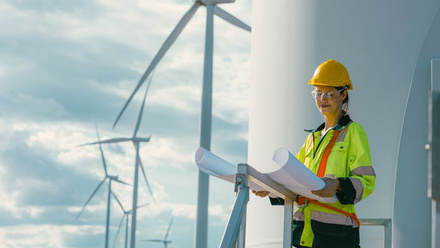Making green hydrogen a cost-competitive climate solution
As global economies increasingly look to be carbon neutral, IRENA sees renewable hydrogen as least cost possible within a decade.
Hydrogen produced with renewable electricity could compete on costs with fossil fuel alternatives by 2030, according to a new report from the International Renewable Energy Agency (IRENA). A combination of falling costs for solar and wind power, improved performance as well as economies of scale for electrolysers could make it possible.
The report, Green Hydrogen Cost Reduction: Scaling up Electrolysers to Meet the 1.5⁰C Climate Goal, looks at drivers for innovation and presents strategies that governments can peruse to reduce the cost of electrolysers by 40% in the short term and by up to 80% in the long term.
Green hydrogen could play a critical role in decarbonisation strategies, particularly so where direct electrification is challenging in harder-to-abate sectors, such as steel, chemicals, long-haul transport, shipping and aviation. However, regulations, market design and the costs of power and electrolyser production are still major barrier to the uptake of green hydrogen.
Currently, green hydrogen is 2-3 times more expensive than blue hydrogen, produced from fossil fuels in combination with carbon capture and storage (CCS). The production cost for green hydrogen is determined by the renewable electricity price, the investment cost of the electrolyser and its operating hours. Renewables have already become the cheapest source of power in many parts of the world, with auctions reaching record price-lows below US$20 per megawatt-hour (MWh). While low-cost electricity is a necessary condition for competitive green hydrogen, investment costs for electrolysis facilities must fall significantly too.
IRENA’s new study identifies key strategies and policies to reduce costs for electrolysers through innovation and improved performance aiming to scale up electrolysers from today’s megawatt to multi-gigawatt (GW) levels. Standardisation and mass-manufacturing of the electrolyser stacks, efficiency in operation as well as the optimisation of material procurement and supply chains will be equally important to bring down costs. For that, today’s manufacturing capacity of less than 1 GW would have to massively grow beyond 100 GW in the next 10 to 15 years.
In the best-case scenario, using low-cost renewable electricity at US$20 USD/MWh in large, cost-competitive electrolyser facilities could produce green hydrogen at a competitive cost with blue hydrogen already today. If rapid scale-up and aggressive electrolysers deployment take place in the next decade, green hydrogen could then start competing on costs with blue hydrogen by 2030 in many countries, making it cheaper than other low-carbon alternatives before 2040, IRENA’s analysis shows.
Read the full report Green Hydrogen Cost Reduction: Scaling up Electrolysers to Meet the 1.5⁰C Climate Goal.







